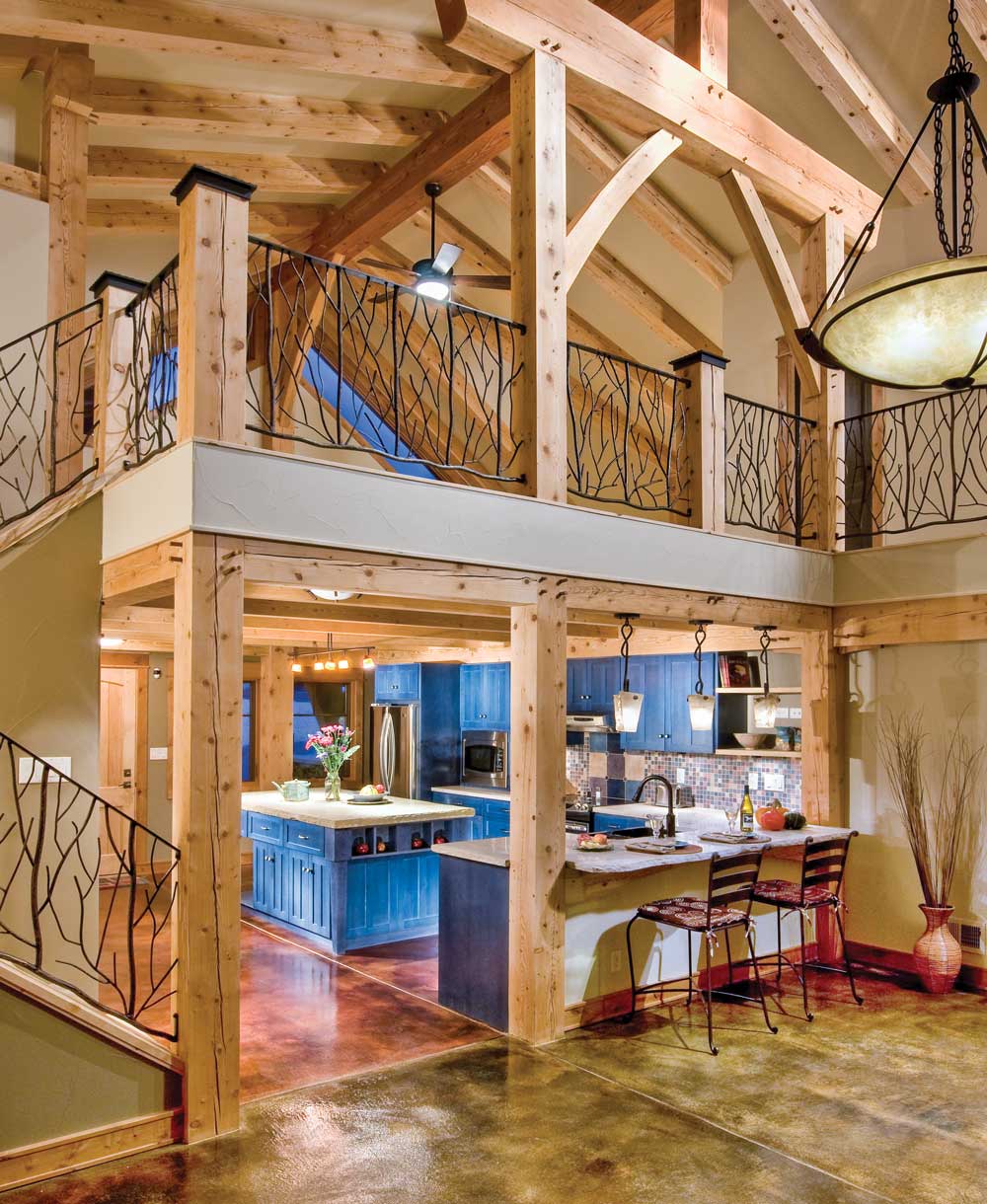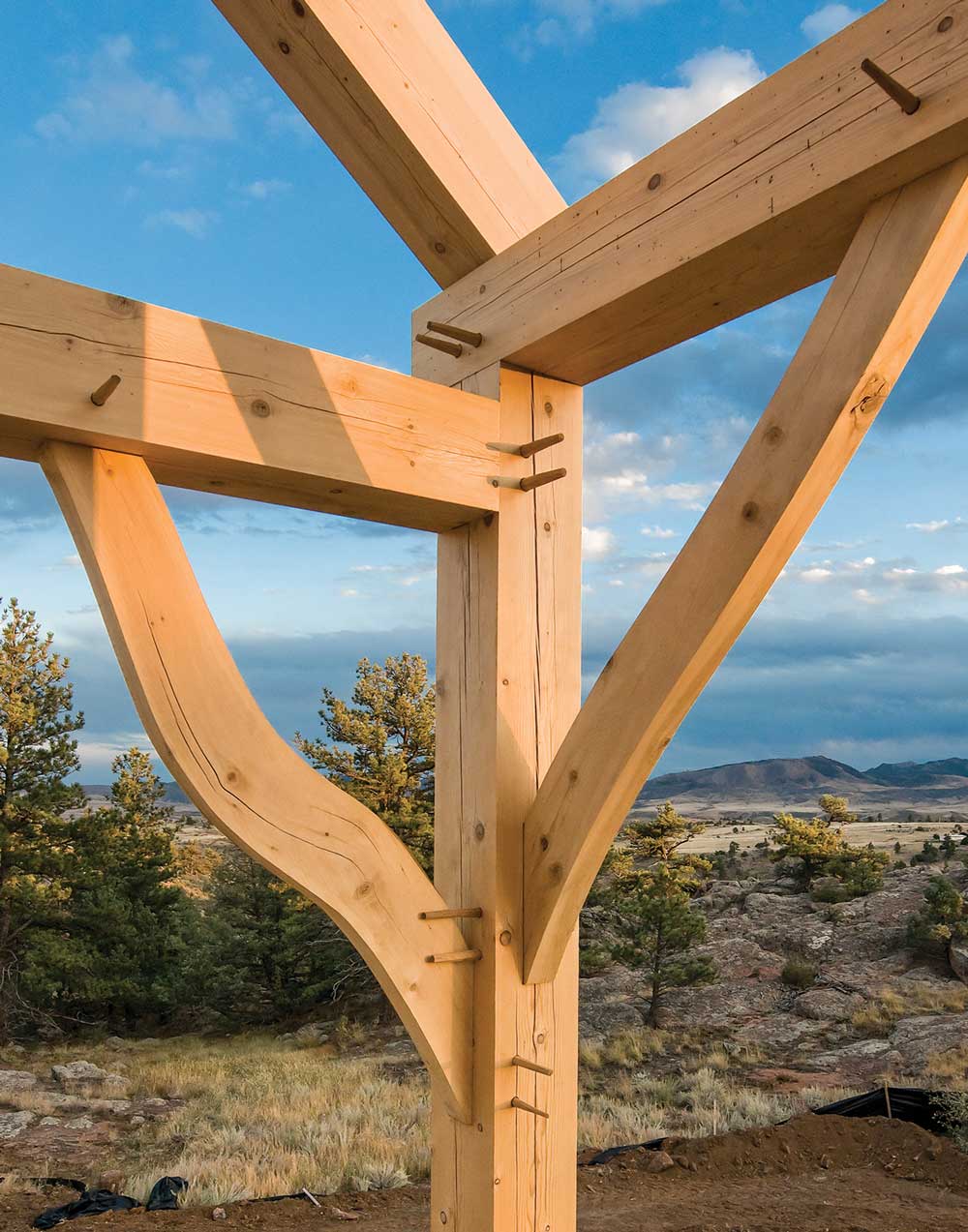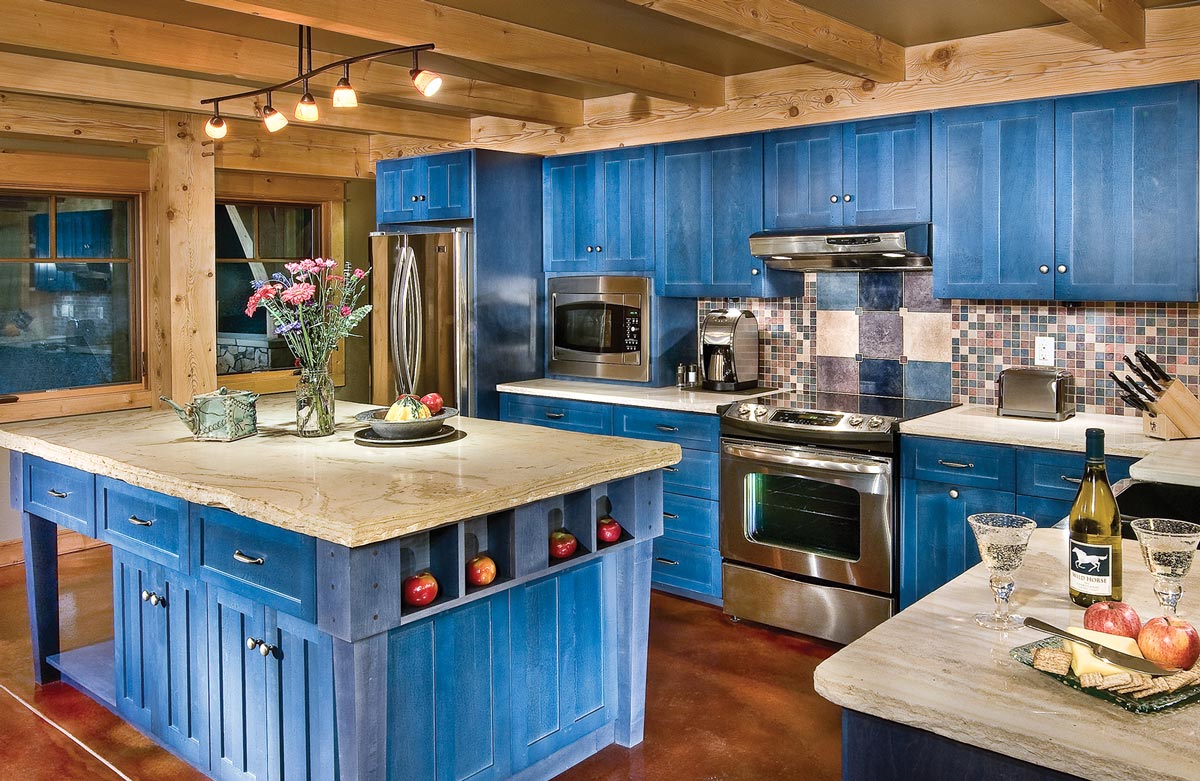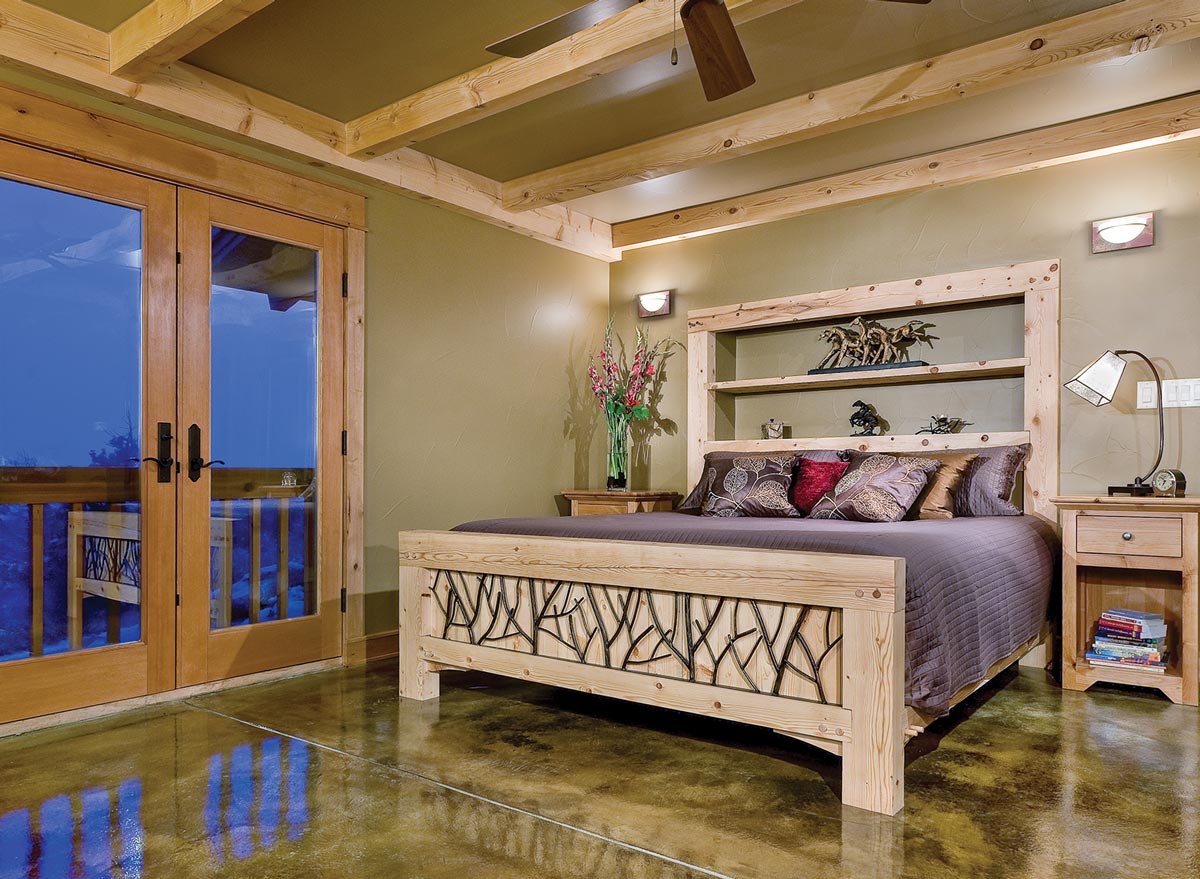
Jim and Nancy Carpenter always wanted to build a log cabin in the mountains. Their Livermore retreat—a beautiful, eco-friendly haven on the Front Range—ended up surpassing their wildest dreams.
By Christine Lejeune
photography By daniel o’conner
Jim and Nancy Carpenter always knew that they’d end up in the mountains. No matter that they were born and bred Midwesterners; they’d both had spent significant time in Montana growing up, and they’d bonded early in their relationship over their mutual love of the natural beauty and grandeur of the West. They dreamed of one day building a log cabin with a view of the Rockies.
For years, the Carpenters—who’d settled, raised a family and built a business in a pretty little suburb of Indianapolis—had simply gotten their mountain fix with vacations, traveling out West whenever they could. “But we always had that idea in our minds,” Jim Carpenter says. “Wouldn’t it be great to have a place out here somewhere?” It wasn’t until 2008 that the dream actually took root at Phantom Canyon Ranch, the massive Livermore ranch-focused development with some 1,100 acres of The Nature Conservancy’s protected Phantom Canyon Reserve at its center.
“It was awe at first sight,” Carpenter says. “There were these beautiful granite boulders all around, the Ponderosa pines, the vistas that go on and on.” They couldn’t imagine a better fit for themselves. The lifelong nature-lovers, both of whom are biologists and steadfast conservationists (in 1981, Jim founded the nature shop Wild Birds Unlimited), were drawn to everything about the place.

The delicate welded-metal railing that runs along the loft and outside on the master bedroom’s deck was designed and created by Creative Welding and Fabrication in Fort Collins.
“It’s a 10,000-acre ranch that contains, at this point, only about 35 building sites,” Carpenter says—and all of the homes are required to blend into natural surroundings, to essentially be invisible from the roads and trails, and to leave the land outside the two-acre building envelope untouched. “No matter where you are, for the most part, you really feel like you’re there by yourself. It’s a beautiful experience: You can see the stars and the wildlife.” Not to mention the giant nature preserve at the heart of the land, the breathtaking view of the Front Range, and the North Puta River, which runs through the center of it all. “It’s sort of like feeling as if you have your own national park,” Carpenter says.
The couple were so enamored of the land that they bought it, thinking that they’d use it as a sort of personal campground, a place to explore and enjoy when they came out on vacation. “But after a year, we decided, ‘No, we have to spend more time here,’” Carpenter says. They decided to build a real retreat. They found a green builder—Merton Construction—at a sustainable living fair in Fort Collins; Merton (which is no longer in business) worked with seasoned architect Mark Quéripel at MQ Architecture in Boulder to design a timber-frame cabin for their land.
“
It’s a beautiful experience… sort of like feeling as if you have your own National Park…
“
“I’d say it’s more like a cabin on steroids,” says Morgan Cate of the 2,300-square-foot, three-bedroom, three-bathroom home. Cate was the construction manager with Merton who worked on the project alongside Merton’s architect, Robert Ross; today, Cate runs Adaptive Habitat, his own three-year-old firm that specializes in building green, custom homes. The Carpenter house remains one of his favorite projects, he says—and it’s easy to see why. The finished product is a stunner, featuring striking white fir beams that help frame the 900-square-foot loft area; warm terra-stained floors; custom everything (from the kitchen cabinets made to order out of Boulder to the tilework in the master bathroom, which contains an inlaid “creek” made from rounded river rock that Nancy Carpenter found at the property); and, of course, the sort of views you’d expect from that location: a 360-degree view of the prairie, the foothills, the Front Range. “We call the deck on top of the garage ‘The Lookout,’” Nancy Carpenter says, with a laugh. Cate agrees: “That panorama is the best view in Northern Colorado that I know of.”

The timber frame was created off-site in Fort Collins by Frameworks Timber. When it was erected, the Carpenters threw a party. “It almost like a barn-raising,” Nancy Carpenter says. “We had all the neighbors over, some friends and family, kegs and caterers, two bluegrass bands, and we had fun, sitting there, under the stars.
In fact, it was the location of the house that dictated just about every detail of its construction and design, from the materials used (local white and Douglas firs, beetle-kill pine from up the hill, boulders and stones quarried from nearby Laporte or found on the property itself) to the timber frame itself, which was paired with structural insulation panels that would be sturdy enough to weather the constant exposure to the driving winds, the extreme cold and heat, the freezing and thawing of the Front Range. “We’d tossed around a lot of ideas, but I’m so glad we ended up with that timber frame,” Jim Carpenter says. “Even when the winds are howling, it’s so cozy and warm in there.”
Another important factor in the design was the Carpenters’ commitment to being as green and eco-conscious as possible. That translated to a whole series of cool features in the home that went beyond just the use of natural and local materials: The home features a passive solar design with solar radiant floor heating and a solar-powered back-up battery, as well as a roof made of entirely of tiles reclaimed from another building project and a natural ventilation system for cooling (including a whole-house fan).
“You don’t feel bad turning up the thermostat, because that energy is coming from the sun,” Carpenter says. “And the hot water, too.” In fact, not only was the house granted LEED Gold certification—a rarity in residential projects—but in 2012, a couple of years after the Carpenters moved in, it was honored by the American Institute of Architects as the region’s most sustainable single-residence custom home of its size.
“
You know, it was a priority for us—we wanted to be green.
“

Custom cabinetry is by Hanley’s Woodworks out of Boulder.
“You know, it was a priority for us. We wanted to be green,” Carpenter says. “At the time, a lot of the technology was emerging and changing, and truthfully, it wasn’t necessarily the cheapest thing to do. But we felt like if it cost us a bit more, we would get it back over the years, not paying electricity costs. And also because we really wanted to help some of these great fledgling green businesses in the area.”

The custom bed riffs off the home’s timber framing and metalwork elements.

Many of the stones used in the fireplace were handpicked by the homeowners from their surrounding land.
In the end, Jim Carpenter says, they couldn’t be happier with their mountain home and with the team they assembled to create it. They’ve since called Cate at Adaptive Habitat back to add on their two-car garage (and its beloved “lookout” perch), as well as a deck off the master bedroom. As for future projects, Carpenter says, they have no current plans to do anything else—though they did buy more land in Phantom Canyon, down in the valley, not to build on, but to preserve. (In fact, they did hire Cate to restore an early homestead cabin on the property—again, not to inhabit, just to preserve.) The rest of the land they lease to local cattle ranchers. .They even bought a cow, a Scottish highland named Dolly, whom they visit from time to time. As Cate observes: “A big part of this is that the Carpenters are true stewards of the land.”
“We’ve just been so happy and thrilled with it all,” Nancy Carpenter says. Not only have they made a real home in the mountains, she says, meeting the neighbors, making friends, but “I’m just so grateful that we have a place like this, and a place like Phantom Canyon that allows us to live in a real wild place, to really live in a green way and be part of an authentic Western community. This is the real deal. And we just feel so lucky.”